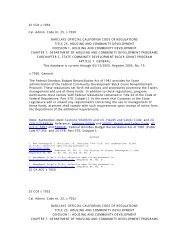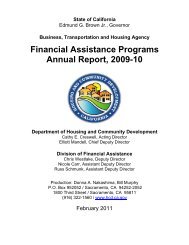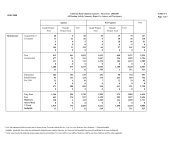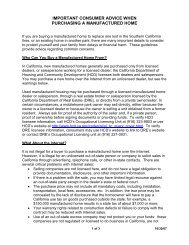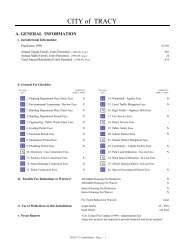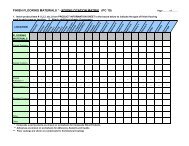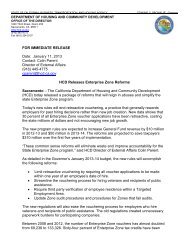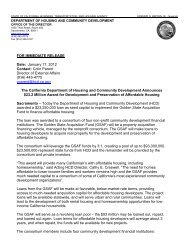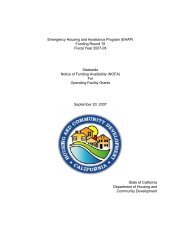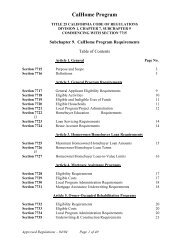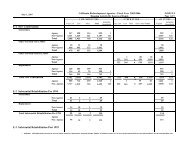Adobe PDF - California Department of Housing and Community ...
Adobe PDF - California Department of Housing and Community ...
Adobe PDF - California Department of Housing and Community ...
You also want an ePaper? Increase the reach of your titles
YUMPU automatically turns print PDFs into web optimized ePapers that Google loves.
PUBLIC REVENUES - REGULATIONS <br />
retail an amount from a consumer in reimbursement <strong>of</strong> the sales tax upon gross receipts shall compute the amount <strong>of</strong><br />
reimbursement by reference to schedules prepared by the board pursuant to Civil Code Section 1656.1 or by mathematical<br />
computation as described below. Schedules are available from the local district board <strong>of</strong>fices for the various applicable rates.<br />
Reimbursement on sales prices in excess <strong>of</strong> those shown in the schedules provided by the board may be computed by<br />
applying the applicable tax rate to the sales price, rounded <strong>of</strong>f to the nearest cent by eliminating any fraction less than<br />
one-half cent <strong>and</strong> increasing any fraction <strong>of</strong> one-half cent or over to the next higher cent.<br />
(b) Excess Tax Reimbursement.<br />
(1) Definition. When an amount represented by a person to a customer as constituting reimbursement for sales tax<br />
is computed upon an amount that is not taxable or is in excess <strong>of</strong> the taxable amount <strong>and</strong> is actually paid by the customer to the<br />
person, the amount so paid is excess tax reimbursement. Excess tax reimbursement is charged when reimbursement<br />
is computed on a transaction which is not subject to tax, when reimbursement is computed on an amount in excess <strong>of</strong> the<br />
amount subject to tax, when reimbursement is computed using a tax rate higher than the rate imposed by law, <strong>and</strong> when<br />
mathematical or clerical errors result in an overstatement <strong>of</strong> the reimbursement on a billing.<br />
(2) Procedure upon Ascertainment <strong>of</strong> Excess Tax Reimbursement. Whenever the board ascertains that a person has<br />
collected excess tax reimbursement, the person will be afforded an opportunity to refund the excess collections to the<br />
customers from whom they were collected. In the event <strong>of</strong> failure or refusal <strong>of</strong> the person to make such refunds, the<br />
board will make a determination against the person for the amount <strong>of</strong> the excess tax reimbursement collected <strong>and</strong> not<br />
previously paid to the state, plus applicable interest <strong>and</strong> penalty.<br />
(3) Evidence Sufficient to Establish that Excess Amounts have been or will be returned to Customer.<br />
(A) If a person already has refunded to each customer amounts collected as reimbursement for tax in excess <strong>of</strong> the<br />
tax due, this may be evidenced by any type <strong>of</strong> record which can be verified by audit such as:<br />
1. Receipts or cancelled checks.<br />
2. Books <strong>of</strong> account showing that credit has been allowed the customer as an <strong>of</strong>fset against an existing<br />
indebtedness owed by the customer to the person.<br />
(B) If a person has not already made sales tax reimbursement refunds to each customer but desires to do so<br />
rather than incur an obligation to the state, the person must:<br />
1. Inform in writing each customer from whom an excess amount was collected that the excess amount collected<br />
will be refunded to the customer or that, at the customer's option, the customer will be credited with such amount, <strong>and</strong><br />
2. The person must obtain <strong>and</strong> retain for verification by the board an acknowledgement from the customer that the<br />
customer has received notice <strong>of</strong> the amount <strong>of</strong> indebtedness <strong>of</strong> the person to the customer.<br />
(4) Offsets. If a person who has collected excess tax reimbursement on a transaction fails or refuses to refund it to<br />
the customer from whom it was collected, the excess tax reimbursement shall be <strong>of</strong>fset against any tax liability <strong>of</strong> the taxpayer<br />
on the same transaction. Any excess tax reimbursement remaining after the <strong>of</strong>fset must be refunded to the customer or paid<br />
to the state. The <strong>of</strong>fset can be made when returns are filed, when a determination is issued, or when a refund is claimed.<br />
Such <strong>of</strong>fsets can be made only on a transaction by transaction basis. Tax reimbursement collected on a specific transaction<br />
can be used only to satisfy a tax liability arising from the same transaction. The “same transaction” means all activities<br />
involved in the acquisition <strong>and</strong> disposition <strong>of</strong> the same property. The “same transaction” may involve several persons, such<br />
as a vendor, a subcontractor, a prime contractor, <strong>and</strong> the final customer; or a vendor, a lessor, <strong>and</strong> a series <strong>of</strong><br />
sublessors. Tax reimbursement can be <strong>of</strong>fset against the tax liability <strong>of</strong> the taxpayer whether the liability was satisfied by<br />
paying sales tax reimbursement to a vendor, paying use tax to a vendor, or paying use tax to the state.<br />
An <strong>of</strong>fset <strong>of</strong> a taxpayer's own tax liability against tax reimbursement collected from a customer can be made only with<br />
respect to transactions in which possession <strong>of</strong> the property upon which the taxpayer's tax liability is based is transferred,<br />
either permanently or temporarily, to the customer, as in the case <strong>of</strong> construction contracts or leases. A taxpayer such as a<br />
repairman or printer who uses shop supplies or printing aids in performing a job for a customer cannot <strong>of</strong>fset the tax liability<br />
arising from the use <strong>of</strong> the supplies or aids against tax reimbursement collected from the customer.<br />
A person who claims that a tax liability on a transaction should be <strong>of</strong>fset against tax reimbursement paid to the state<br />
by another person has the burden <strong>of</strong> proving that tax reimbursement was in fact paid to the state on the same transaction by<br />
the other person. In the absence <strong>of</strong> such pro<strong>of</strong> no <strong>of</strong>fset will be allowed.<br />
The <strong>of</strong>fset allowances explained above are procedural changes m<strong>and</strong>ated by statute <strong>and</strong> apply to all proceedings<br />
pending before the board on <strong>and</strong> after September 7, 1982.<br />
(5) Particular Applications. (Examples at 6 percent tax rate.)<br />
(A) Discounts <strong>and</strong> trading stamps.<br />
1. Discounts. A retailer who allows discounts on sales prices but charges customers tax reimbursement computed<br />
upon the prices before the discount is deducted is collecting excess reimbursement.<br />
For example, a sale is made for $100 plus $6 as tax reimbursement. Upon payment for the item the purchaser is allowed<br />
a discount <strong>of</strong> 20 percent <strong>of</strong> the sales price <strong>of</strong> $100 but the $6 tax reimbursement is excluded from the computation.<br />
Since the retailer is deducting the amount <strong>of</strong> the discount, $20, from taxable gross receipts, the retailer is actually paying a<br />
tax <strong>of</strong> only $4.80, i.e., 6 percent <strong>of</strong> $80, <strong>and</strong> has retained excessive tax reimbursement <strong>of</strong> $1.20.<br />
2. Trading Stamps. A retailer who issues trading stamps or similar evidences <strong>of</strong> patronage may deduct as cash<br />
discounts the cost to the retailer <strong>of</strong> the stamps or other indicia (hereinafter called “stamps”) issued in connection with<br />
taxable retail sales. A retailer who deducts the cost <strong>of</strong> stamps as a cash discount in computing the tax payable to the state,<br />
but who charges tax reimbursement on the full sales price <strong>of</strong> the goods, collects more tax reimbursement than the retailer<br />
pays to the state. The following illustration shows why this is true: If a retailer collects sales tax reimbursement <strong>of</strong> $6 on<br />
a $100 sale but gives the customer trading stamps which cost the retailer $2 <strong>and</strong> then deducts the $2 as a cash discount<br />
when reporting taxable receipts, the retailer will pay a tax <strong>of</strong> only $5.88 (6 percent <strong>of</strong> $98).<br />
170



